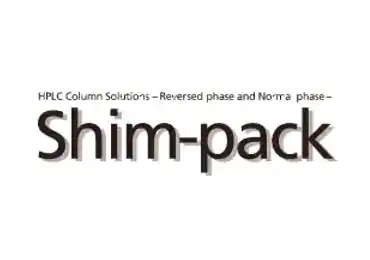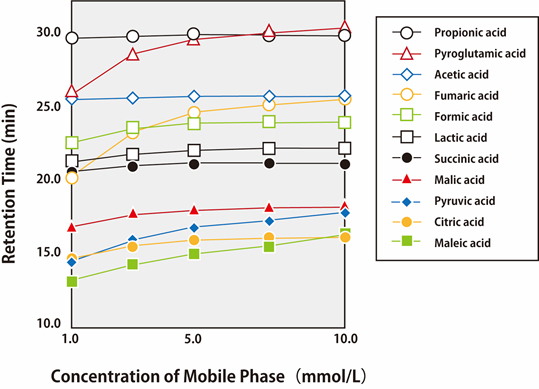
Shim-pack SCR Series
Shim-pack SCR -102 H column for organic acid analysis is a column with an ion exclusion mode with high selectivity for the separation of weak acids. It is recommended to use one column for the analysis of 1 to 5 carbon fatty acids in fermentation samples and two columns for the simultaneous analysis of many organic acids including phosphoric acid. Also, guard columns should be used for column protection.
When analyzing organic acids using Shim-pack SCR-102H for separation, the retention can be adjusted by changing 1) the temperature of the column oven and 2) the concentration of the mobile phase (p-toluenesulfonic acid aqueous solution) . In the case the separation of each of target organic acids is insufficient, it may be improved by changing the temperature for column oven firstly and then changing the concentration of the mobile phase to adjust the retention.
Fig.1 shows the retention behavior when an organic acid is analyzed using a single Shim-pack SCR-102H and a mobile phase (5 mmol / L p-toluenesulfonic acid aqueous solution) under standard analytical conditions for Organic Acids Analysis System. The elution order of fumaric acid and formic acid may change due to changes in column temperature.

Fig.1 Change in Retention Behavior of Organic Acids Corresponding to Column Temperature
(Shim-pack SCR-102H, 1 column)
The standard analytical conditions for Nexera Organic Acids Anlaysis System include 45 degrees Celsius for temperature of column oven and 5 mmol/L p-toluenesulfonic acid aqueous solution for mobile phase. Fig.2 shows the retention behavior when concentration of the mobile phase is changed. When the separation of each organic acid is insufficient, the separation may be improved as a result of adjusting the retention by changing the mobile phase concentration.
*When changing the mobile phase concentration, please note to the following points.
1)The concentration of p-toluenesulfonic acid aqueous solution in the reaction solution should be the same as that in the mobile phase.
2) When changing the mobile phase concentration, the ratio of the concentration of bistoris and EDTA to the mobile phase concentration in the reaction solution should be adjusted to correspond to the ratio of the solute in the reaction solution under the standard analytical conditions.

Fig.2 Change in Retention Behavior of Organic Acids Corresponding to Concentration of Mobile Phase
(Shim-pack SCR-102H, 2 columns)